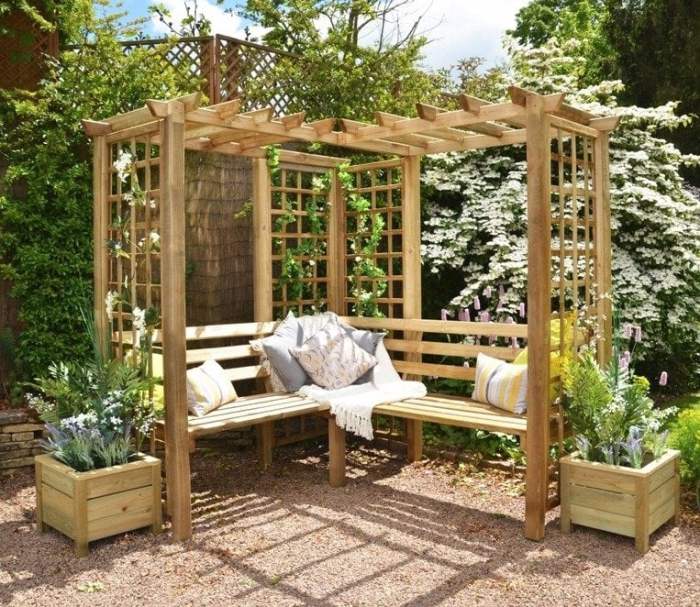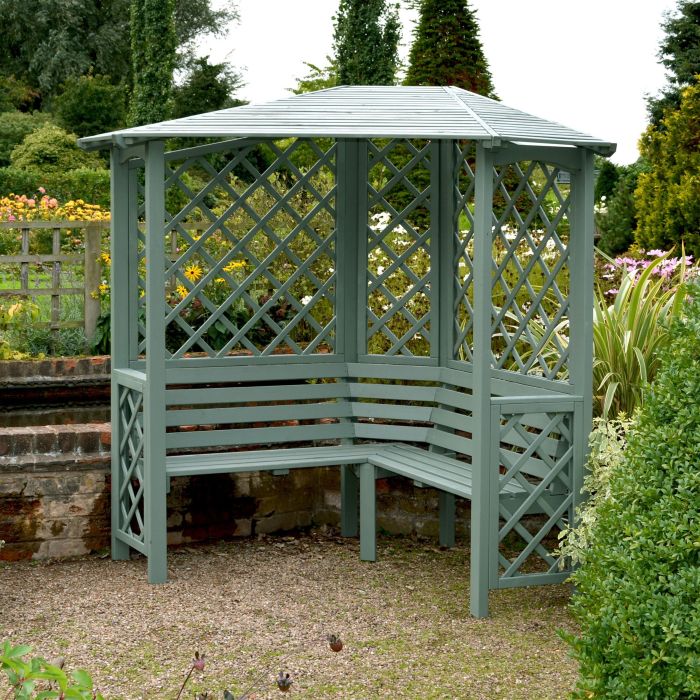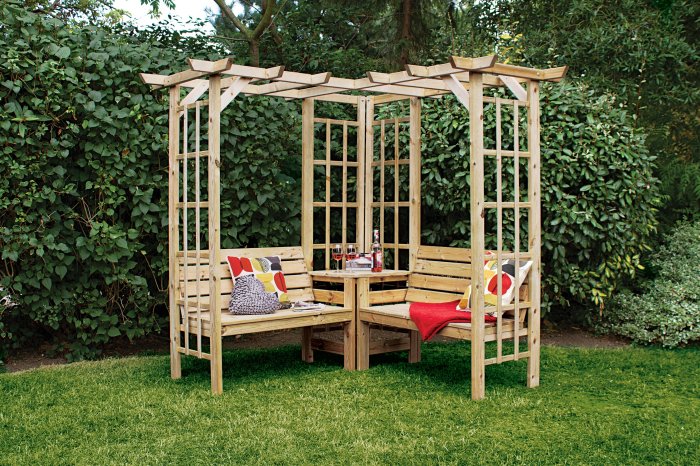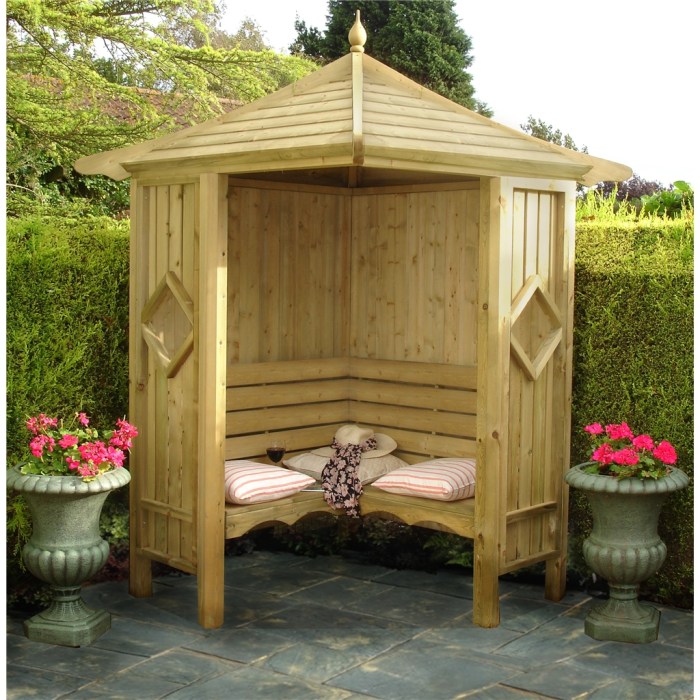Corner arbour ideas offer a wealth of inspiration for creating a secluded and stylish retreat in your garden. These enchanting structures, nestled in the corner of your outdoor space, provide a tranquil haven for relaxation, entertaining, and escaping the hustle and bustle of everyday life.
From charming wooden arbours adorned with climbing roses to sleek metal gazebos with panoramic views, the possibilities for corner arbour design are endless. Whether you seek a romantic hideaway or a functional seating area, this guide will provide you with all the inspiration and practical advice you need to create the perfect corner arbour for your home.
Corner Arbour Design Ideas

Corner arbours add charm and functionality to any outdoor space. They provide a shaded retreat, a focal point for the garden, and an intimate setting for relaxation or entertaining. When designing a corner arbour, consider the architectural style of your home and garden, as well as the materials and finishes that will best complement the surroundings.
For a traditional look, opt for a classic wooden arbour with latticework sides and a pitched roof. Paint it in a neutral colour to blend with the landscape or add a pop of colour to brighten up the space. For a more modern look, choose a metal arbour with clean lines and geometric shapes.
You can also find arbours made from recycled materials, such as reclaimed wood or metal, for a unique and sustainable option.
Unique Corner Arbour Designs
In addition to traditional and modern designs, there are many unique and innovative corner arbours to choose from. Some popular options include:
- Arbours with built-in seating, providing a comfortable place to relax and enjoy the outdoors.
- Arbours with trellises or pergolas, which can be used to support climbing plants and create a lush, shaded canopy.
- Arbours with water features, such as a fountain or waterfall, to add a touch of tranquility to the space.
- Arbours with lighting, to create a magical ambiance in the evening.
Materials for Corner Arbours

Selecting the right materials for your corner arbour is crucial to ensure durability, aesthetic appeal, and functionality. Here’s a comparison of the most common materials:
Wood
- Advantages: Natural beauty, warmth, and versatility; can be painted or stained to match any décor; relatively easy to work with and repair.
- Disadvantages: Requires regular maintenance (staining or sealing) to prevent rot and decay; susceptible to termites and other pests; can be more expensive than other materials.
Metal
- Advantages: Extremely durable and weather-resistant; low maintenance; can be powder-coated or painted for a variety of finishes.
- Disadvantages: Can be more expensive than wood; can get hot in direct sunlight; may require welding or specialized tools for assembly.
Composite Materials
- Advantages: Combines the benefits of wood and metal; durable, weather-resistant, and low maintenance; available in a range of colors and textures to mimic natural materials.
- Disadvantages: Can be more expensive than wood or metal; may not have the same aesthetic appeal as natural materials.
Consider your budget, design preferences, and maintenance requirements when choosing the best materials for your corner arbour.
Corner Arbour Landscaping
Landscaping around corner arbours plays a crucial role in enhancing their aesthetic appeal and creating a harmonious outdoor space. It involves selecting plants and flowers that complement the arbour’s design and establish a welcoming atmosphere. Additionally, integrating the arbour into the surrounding garden ensures a cohesive and well-rounded landscape.
Choosing Plants and Flowers
- Consider the arbour’s design and materials when selecting plants. For instance, a rustic wooden arbour may be complemented by climbing roses or ivy, while a metal arbour may suit trailing flowers like petunias or nasturtiums.
- Choose plants that provide a variety of textures and colors to create visual interest. Evergreen shrubs or vines can offer year-round greenery, while seasonal flowers can add vibrant pops of color during different times of the year.
- Pay attention to the mature size of plants to avoid overcrowding or blocking the arbour’s entrance.
Integrating the Arbour into the Garden
To create a seamless transition between the arbour and the surrounding garden, consider the following strategies:
- Plant groundcovers or low-growing shrubs around the base of the arbour to create a natural transition from the lawn or walkway.
- Use stepping stones or a small pathway to lead visitors to the arbour, creating a sense of anticipation and visual interest.
- Incorporate the arbour into a larger garden design by creating a focal point or defining a specific area, such as a seating area or dining space.
Corner Arbour Seating: Corner Arbour Ideas

Corner arbours provide a perfect spot for relaxation and enjoyment in the outdoors. Comfortable and stylish seating arrangements are essential to create an inviting space. Let’s explore some creative ideas for corner arbour seating.
Choose comfortable seating options that complement the design of your arbour. Benches are a classic choice, offering ample seating for multiple people. They can be made from various materials such as wood, metal, or wicker.
Types of Seating
- Benches:Provide ample seating, customizable with cushions and pillows.
- Chairs:Offer individual comfort and can be arranged flexibly.
- Swings:Add a touch of fun and relaxation, especially suitable for arbours with open views.
Cushions and pillows add comfort and style to your seating. Select fabrics that are weather-resistant and easy to clean. Consider adding throws or blankets for extra warmth on cooler evenings.
Cushions and Accessories
- Cushions:Enhance comfort and add colour to your seating.
- Pillows:Provide lumbar support and create a cozy atmosphere.
- Throws and blankets:Add warmth and style, especially for evening gatherings.
Corner Arbour Lighting

Proper lighting can create a warm and inviting ambiance in corner arbours, making them perfect for relaxing and enjoying the outdoors at any time of day. There are several lighting options to consider, each with its own unique advantages.
Natural Light
Natural light is the most cost-effective and environmentally friendly option for lighting corner arbours. Maximizing natural light during the day can be achieved by choosing a location that receives ample sunlight and installing windows or skylights.
Electric Lights
Electric lights provide a more consistent and controllable source of light for corner arbours. They can be used to create different moods and atmospheres, depending on the type of lighting fixtures chosen. Consider using dimmable lights to adjust the intensity for various occasions.
Candles
Candles add a touch of romance and coziness to corner arbours. They are a great option for creating a warm and inviting ambiance, especially in the evenings. However, it’s important to use candles safely and never leave them unattended.
Placement and Intensity
The placement and intensity of lighting in corner arbours should be carefully considered. For general illumination, place lights evenly throughout the space. For task lighting, such as reading or working, consider using focused lighting fixtures like spotlights or table lamps.
Adjust the intensity of the lighting based on the desired ambiance, whether it’s bright and cheerful or dim and romantic.
Corner Arbour Accessories
Accessorizing your corner arbour can transform it into a personal sanctuary. Curtains and screens provide privacy and shade, while decorative elements add a touch of style.
Curtains and Screens
Choose curtains or screens that complement the arbour’s design. Sheer fabrics create an airy, romantic atmosphere, while heavier fabrics offer more privacy. Screens can be made from wood, bamboo, or metal, and provide a more structured look.
Artwork and Sculptures
Add artwork or sculptures to create a focal point. Choose pieces that reflect your personal style and the overall ambiance you want to create. A small fountain or water feature can add a soothing touch.
Other Decorative Touches
Other decorative touches can include:
- Throw pillows and cushions for comfort
- Lanterns or candles for evening ambiance
- Plants and flowers for a touch of nature
- Rugs or mats to define the space
Corner Arbour Privacy
Corner arbours can be secluded retreats that offer respite from the hustle and bustle of everyday life. To ensure privacy and seclusion, there are several strategies to consider.One effective method is to use trellises or screens. Trellises can be adorned with climbing plants, such as ivy or clematis, which create a living wall that both conceals and beautifies the space.
Screens, made from materials like bamboo or latticework, provide a more immediate and solid barrier.
Positioning and Spacing of Plants
When using plants for screening, careful consideration should be given to their positioning and spacing. Taller plants should be placed in the background, with shorter plants in front. This creates a layered effect that helps to obscure views from outside.
It’s also important to ensure that plants are spaced far enough apart to allow for proper airflow and prevent disease.
Corner Arbour Maintenance
Preserve the beauty and longevity of your corner arbour with meticulous maintenance. Regular cleaning, painting, and repairs will ensure it remains a cherished outdoor sanctuary.
Regular Cleaning
- Sweep or vacuum away dirt, leaves, and debris to prevent buildup.
- Wipe down surfaces with a damp cloth to remove dust and grime.
- Use a mild detergent and water solution for stubborn stains.
Painting and Repairs
- Inspect the arbour regularly for peeling paint or cracks.
- Sand down any rough areas and apply a fresh coat of paint.
- Make timely repairs to damaged latticework or supports.
Protection from Weather and Pests, Corner arbour ideas
- Apply a sealant to the arbour to protect it from rain and UV damage.
- Inspect the arbour for signs of pests like termites or wood-boring insects.
- Treat the arbour with appropriate pesticides or repellents as necessary.
Corner Arbour History and Inspiration
Corner arbours have a rich history and cultural significance, dating back centuries.
In ancient times, arbours were used as places of shelter and respite from the sun and rain. They were often built in gardens and parks, and were used for relaxation and contemplation.
Iconic Corner Arbours
- The Summerhouse at Blenheim Palace, England:This iconic corner arbour was built in the 18th century and is one of the most famous in the world.
- The Pergola at the Villa d’Este, Italy:This beautiful pergola is located in the gardens of the Villa d’Este in Tivoli, Italy. It is a UNESCO World Heritage Site.
- The Rose Garden at the Huntington Library, California:This beautiful rose garden features a number of corner arbours, which are used for weddings and other special events.
Corner Arbour DIY Projects
DIY corner arbours are a great way to add beauty and functionality to your backyard. With a little planning and effort, you can build a corner arbour that will be the perfect spot to relax and enjoy the outdoors.Before you start, it’s important to choose the right location for your corner arbour.
You’ll want to find a spot that is level and has good drainage. You’ll also want to make sure that the arbour will be in a location where you can enjoy the shade and breeze.Once you’ve chosen a location, it’s time to start gathering your materials.
You’ll need:
- 4×4 posts
- 2×4 lumber
- Roofing material
- Nails or screws
- A saw
- A drill
- A level
- A tape measure
Once you have all of your materials, you can start building your corner arbour.
- Start by cutting the 4×4 posts to the desired height. The height of the posts will depend on the size of the arbour you want to build.
- Once the posts are cut, dig four holes in the ground, each hole about 2 feet deep.
- Place the posts in the holes and fill the holes with concrete.
- Allow the concrete to dry for at least 24 hours.
- Once the concrete is dry, you can start framing the arbour. Cut the 2×4 lumber to the desired length and nail or screw the lumber to the posts.
- Once the frame is complete, you can add the roofing material. You can use any type of roofing material you like, such as shingles, metal, or tar paper.
- Once the roofing material is installed, your corner arbour is complete! You can now enjoy your new outdoor space.
Corner Arbour Table Ideas
Corner arbours provide a charming and intimate space for relaxation and entertainment. A well-chosen table can enhance the functionality and style of your corner arbour. Consider the following factors when selecting a table:
-
-*Size and shape
Choose a table that is proportionate to the size of your arbour. A round or oval table can create a more intimate setting, while a rectangular or square table offers more space for dining or entertaining.
-*Material
Consider the materials used to construct the table. Wood is a classic choice that can be stained or painted to match your arbour. Metal tables are durable and easy to maintain. Plastic tables are lightweight and affordable, but they may not be as durable as other materials.
-*Style
The style of the table should complement the overall design of your arbour. A rustic table made from reclaimed wood can add a touch of charm, while a sleek modern table can create a more contemporary look.
Table Decorations and Accessories
Once you have chosen a table, you can add decorations and accessories to complete the look. Consider the following ideas:
-
-*Tablecloth
A tablecloth can add a touch of elegance to your table. Choose a fabric that complements the style of your arbour and the season.
-*Centerpiece
A centerpiece can add a focal point to your table. Consider using flowers, candles, or other decorative items to create a stunning display.
-*Placemats and napkins
Placemats and napkins can help to protect your table from spills and stains. They can also add a touch of color and style to your setting.
-*Serving dishes
Serving dishes are essential for any table. Choose dishes that are both functional and stylish. Consider using different shapes and sizes to create a visually appealing display.
By following these tips, you can choose a table that will perfectly complement your corner arbour and create a beautiful and inviting space for relaxation and entertainment.
Final Wrap-Up
Corner arbours are not merely structures; they are expressions of creativity and personal style. By embracing the ideas presented in this guide, you can transform a simple corner of your garden into an extraordinary outdoor sanctuary. So let your imagination soar, gather your materials, and embark on the journey of creating your own corner arbour oasis.
Clarifying Questions
What are the most popular materials for corner arbours?
Wood, metal, and composite materials are the most commonly used materials for corner arbours. Wood offers a classic and natural look, while metal provides durability and a modern aesthetic. Composite materials combine the advantages of both wood and metal, offering a low-maintenance and weather-resistant option.
How can I ensure privacy in my corner arbour?
To create privacy in your corner arbour, you can use trellises, screens, or hedges. Trellises allow you to grow climbing plants, which can provide a lush and natural privacy screen. Screens offer a more immediate solution, and can be made from materials such as bamboo, canvas, or wood.
Hedges require more time to establish, but can provide a dense and effective privacy barrier.
What are some unique design ideas for corner arbours?
For a unique corner arbour design, consider incorporating curved lines, asymmetrical shapes, or eye-catching architectural details. You could also add a water feature, such as a small fountain or pond, to create a serene and tranquil atmosphere. Another unique idea is to use recycled materials, such as old pallets or reclaimed wood, to create a rustic and sustainable arbour.


